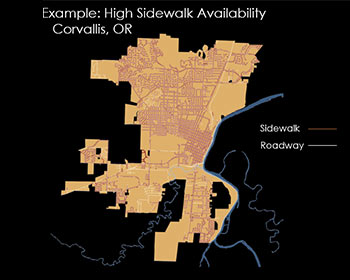Where the Sidewalks End: Evaluating Pedestrian Infrastructure and Equality
Posted: Nov 10, 2021
 Research at the University of Colorado Denver leverages developments in spatial data to advance the literature and improve the understanding of pedestrian infrastructure, city-wide sidewalk characteristics, and the fair distribution of sidewalks. Researchers derived usable GIS sidewalk data from aerial imagery for 24 U.S. cities and then used those data to calculate sidewalk availability, width, and land coverage for every city block in those cities. This facilitated the ability to compare the results against ADA regulations and national and federal guidelines. Results suggest that sidewalk availability averages less than 50%. In other words, assuming that cities should have sidewalks on both sides of most streets, they are not even halfway to that point. In addition, the research found that more than 10% of available sidewalks are not even three feet wide, the minimum needed to meet ADA regulations. The results also suggest that economic and racial inequities exist in cities but not always how we might expect. For instance, non-white populations appear to have generally greater sidewalk availability and width. This project fills a major gap in the literature and does so in a way that should prove to be helpful for cities that want to improve their sidewalk infrastructure.
Research at the University of Colorado Denver leverages developments in spatial data to advance the literature and improve the understanding of pedestrian infrastructure, city-wide sidewalk characteristics, and the fair distribution of sidewalks. Researchers derived usable GIS sidewalk data from aerial imagery for 24 U.S. cities and then used those data to calculate sidewalk availability, width, and land coverage for every city block in those cities. This facilitated the ability to compare the results against ADA regulations and national and federal guidelines. Results suggest that sidewalk availability averages less than 50%. In other words, assuming that cities should have sidewalks on both sides of most streets, they are not even halfway to that point. In addition, the research found that more than 10% of available sidewalks are not even three feet wide, the minimum needed to meet ADA regulations. The results also suggest that economic and racial inequities exist in cities but not always how we might expect. For instance, non-white populations appear to have generally greater sidewalk availability and width. This project fills a major gap in the literature and does so in a way that should prove to be helpful for cities that want to improve their sidewalk infrastructure.
Wesley E. Marshall, Ph.D.
University of Colorado Denver
Where the Sidewalks End: Evaluating Pedestrian Infrastructure and Equality
MPC-21-441